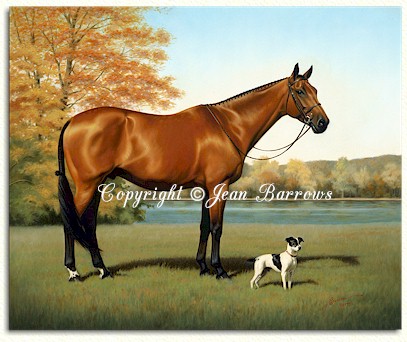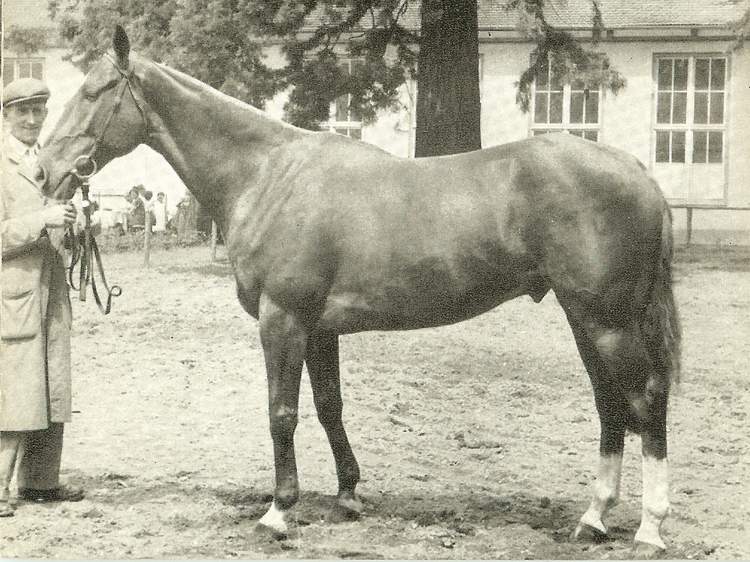

Hunter


Introduction: If you have any comments or suggestions, please click here. The horse in the above right picture may not appear as attractive as the one in the painting on the left, but it is an Irish Hunter, one of the best-bred hunters in the world.
Names: "Hunter" is not a breed name. Any horse that performs creditably on the hunting field may be called a hunter, whether it be an Appaloosa or a Connemara pony. But "hunter" generally refers to an animal of the type specially bred and trained for fox hunting. The breed that dominates among hunters, due to its speed and incredible endurance, is the Thoroughbred. The description given below will be that of a Thoroughbred Hunter. (The latter was my original plan; however, my most recent source speaks of the "English or Irish Hunter" so the kind spoken of will have to be identified by its description until I can sort this page out.)
Origin: The
hunter is found all over the world; I am placing it under England
for now and
will probably have links to it in other countries eventually. Breeding
areas and studs--everywhere in the English-speaking world, particularly in England,
Ireland,
South
Africa and Australia. (Hunters
Improvement and National Light Horse Breeding Society.) Crossing
between Thoroughbred
and local strains since foundation
of the English Thoroughbred.
This type, not breed, of horse is classified according to the
weight of the rider. British standards define a lightweight
Hunter as one which is expected to carry a rider weighing under 182 pounds; a
middleweight Hunter, from 182 to 205 pounds; and a heavyweight
Hunter, over 205 pounds. The height of a Hunter is usually from 63-66
inches. The weight generally ranges from about 1100 pounds for lightweight
Hunters to 1300 pounds for heavyweights. Hunters are derived mainly from
Thoroughbreds, often crossed either with American Saddle, Standardbred, Hackney,
or Cleveland Bay horses, depending upon which weight-class of Hunter is desired.
Sometimes even draft blood is used if a particularly heavy Hunter is wanted.
Breeding: He is anything from a bloodhorse to a native pony and is both rare and extremely expensive. Crossbreeding of Thoroughbreds with cold-blooded horses is sometimes done to produce characteristics such as great size or heavy bone. Breeders in Ireland and England have gotten bold, hardy hunters out of crosses between Thoroughbreds and wild ponies.
Description:
Full,
hard muscling and sound bone give him "substance" to endure the
punishment of the ride, perhaps under a heavy rider. He appears closer to
the ground than his flat-track brother, sturdier through the neck, shoulder, and
barrel. (The hunter, of course, is a mature and fully developed horse,
while the two- or three-year-old race horse is still a juvenile.)
The skeleton of the horse is its inner spring, and the
hunter's is well designed for his function. Powerful hindquarters provide
the lift he needs to sail over obstacles. Sloping shoulders absorb the
shocks of landing. Prominent withers keep the saddle from slipping in the
helter-skelter of the chase. During the long and careful training process,
a hunter's leg bones are allowed the necessary time to "set," to
become dense, hard, resistant to injury. When put to full use at age five,
he is in condition for the worst kind of country. Whereas the hard-used
racing Thoroughbred
is often broken down at age five, the hunter is just
beginning his career.
If the selection for breeding has been done with sufficient
care the result is a good-looking, useful horse. Noble, large-framed, long
lines. The best types acquire fame as show hunters, show jumpers and
point-to-point horses.
Action: Walk; should cover much ground. Fast, striding and enduring gallop. Above-average jumping ability. (The Irish Hunter is generally cleverer and more talented for jumping.)
Size: Heights vary considerably, but seldom below 15.2 hands.
Temperament: Good temper is another quality necessary for the hunter. A field member is no asset to the hunt on a horse that reacts excitedly, kicks at the hounds, refuses jumps, or is disobedient to commands. The animal's inborn disposition has much to do with his deportment, but training is equally important. If properly schooled, the spirited hunter learns to take the most awesome jumps fearlessly and to stay calm amidst the general excitement around him. He will show a knack for doing the sensible thing.
Features: A
good hunter stands quietly, ignores hounds, horses and "refusers," and jumps
anything from wire to water safely and at any speed. He will go first or
last without a fuss, will not pull unduly and has the stamina for two-and-a-half
days' hunting a week throughout the season.
One of my favorite books put it this way: The
beast that can stay the distance and leap like a cat is what makes the hunt, be
he all Thoroughbred, all cart horse, or betwixt and between.
Thoroughbred,
half-bred or pony-bred riding horse with jumping ability and often up to
weight. Energetic, fast and with lots of stamina. Robust, healthy
constitution. Strictly speaking it is not a separate breed, but is
generally a direct corss between the Thoroughbred
stallion and mares of more or less good quality from the counties of England and
Ireland--such as Cleveland
Bay, Suffolk Punch,
Irish
Draught mares. Therefore
it is a half-bred in the true sense of the word.
Uses: The demands of the hunting field require certain qualities in the hunter not associated with the Thoroughbred as flat racer. The streamlined racer propels himself at great speed over a smooth course of less than two miles. The hunter performs as a jumper and a long-distance runner all day over difficult terrain.
Accomplishments:
Curiosities:
Profiles:
Conclusion: